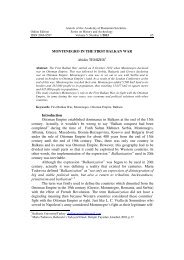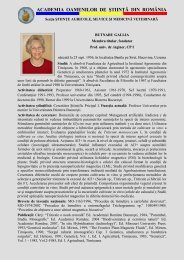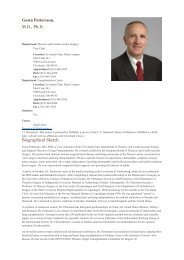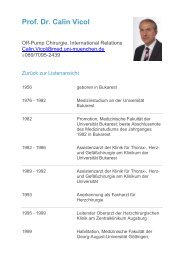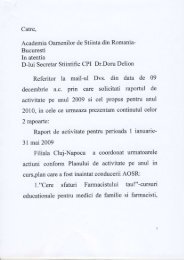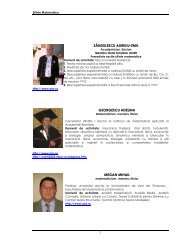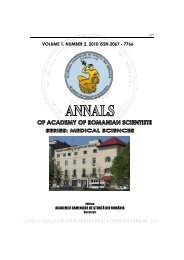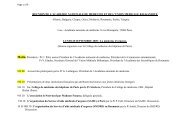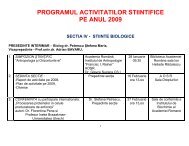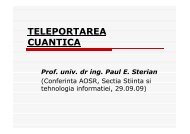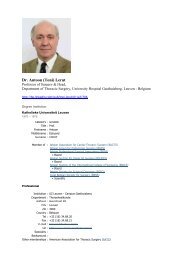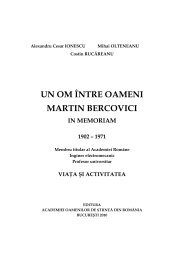- Page 1 and 2: ACADEMY OF ROMANIAN SCIENTISTS ACAD
- Page 3 and 4: A n n i v e r s a r y v o l u m e 1
- Page 5 and 6: 9. D. Şchiopu, T. Schiopu PART FIV
- Page 7 and 8: Annals of the AR S - Anniversary vo
- Page 9 and 10: L‘Académie des Scientifiques de
- Page 11 and 12: L‘Académie des Scientifiques de
- Page 13 and 14: L‘Académie des Scientifiques de
- Page 15 and 16: L‘Académie des Scientifiques de
- Page 17 and 18: L‘Académie des Scientifiques de
- Page 19 and 20: L‘Académie des Scientifiques de
- Page 21 and 22: L‘Académie des Scientifiques de
- Page 23 and 24: L‘Académie des Scientifiques de
- Page 25 and 26: L‘Académie des Scientifiques de
- Page 27 and 28: L‘Académie des Scientifiques de
- Page 29 and 30: DELEGAŢIA PERMANENTĂ COMITETUL DE
- Page 31 and 32: Annales de l‘ASR - Volume anniver
- Page 33 and 34: Annales de l‘ASR - Volume anniver
- Page 35 and 36: Annales de l‘ASR - Volume anniver
- Page 37 and 38: PART ONE SECTION OF MATHEMATICAL AN
- Page 39 and 40: Annals of the ARS - Anniversary vol
- Page 41 and 42: Albert Einstein - A Century from th
- Page 43 and 44: Albert Einstein - A Century from th
- Page 45 and 46: Albert Einstein - A Century from th
- Page 47: Annals of the ARS - Anniversary vol
- Page 51 and 52: Characterization of The Ideal Repos
- Page 53 and 54: Annals of the ARS - Anniversary vol
- Page 55 and 56: Radiotoxicity of CANDU: Clearance I
- Page 57 and 58: Radiotoxicity of CANDU: Clearance I
- Page 59 and 60: sn117m, 1.72E+08, 1% nb 95, 8.84E+0
- Page 61 and 62: Radiotoxicity of CANDU: Clearance I
- Page 63 and 64: Radiotoxicity of CANDU: Clearance I
- Page 65 and 66: Table 5.2.2 Radiotoxicity of CANDU:
- Page 67 and 68: Radiotoxicity of CANDU: Clearance I
- Page 69 and 70: Radiotoxicity of CANDU: Clearance I
- Page 71 and 72: Radiotoxicity of CANDU: Clearance I
- Page 73 and 74: Radiotoxicity of CANDU: Clearance I
- Page 75 and 76: Table 5.3.2 Radiotoxicity of CANDU:
- Page 77 and 78: Radiotoxicity of CANDU: Clearance I
- Page 79 and 80: Radiotoxicity of CANDU: Clearance I
- Page 81 and 82: CONCLUSION Radiotoxicity of CANDU:
- Page 83 and 84: Annals of the ARS - Anniversary vol
- Page 85 and 86: Master Equation of the Matter-Field
- Page 87 and 88: Master Equation of the Matter-Field
- Page 89 and 90: Master Equation of the Matter-Field
- Page 91 and 92: Master Equation of the Matter-Field
- Page 93 and 94: Master Equation of the Matter-Field
- Page 95 and 96: Master Equation of the Matter-Field
- Page 97 and 98: Master Equation of the Matter-Field
- Page 99 and 100:
Master Equation of the Matter-Field
- Page 101 and 102:
Master Equation of the Matter-Field
- Page 103 and 104:
Master Equation of the Matter-Field
- Page 105 and 106:
PART TWO SECTION OF CHEMICAL SCIENC
- Page 107 and 108:
Annals of the ARS - Anniversary vol
- Page 109 and 110:
Mass, Low Cost, Hydrogen Production
- Page 111 and 112:
Mass, Low Cost, Hydrogen Production
- Page 113 and 114:
Mass, Low Cost, Hydrogen Production
- Page 115 and 116:
PART THREE SECTION OF GEONOMICAL SC
- Page 117 and 118:
Annales de l‘ASR - Volume anniver
- Page 119 and 120:
La Géodynamique à l'Échelle Plan
- Page 121 and 122:
La Géodynamique à l'Échelle Plan
- Page 123 and 124:
La Géodynamique à l'Échelle Plan
- Page 125 and 126:
La Géodynamique à l'Échelle Plan
- Page 127 and 128:
La Géodynamique à l'Échelle Plan
- Page 129 and 130:
PART FOUR SECTION OF TEHNICAL SCIEN
- Page 131 and 132:
Annals of the ARS - Anniversary vol
- Page 133 and 134:
Applications of Electromagnetic Com
- Page 135 and 136:
Applications of Electromagnetic Com
- Page 137 and 138:
Applications of Electromagnetic Com
- Page 139 and 140:
Applications of Electromagnetic Com
- Page 141 and 142:
Applications of Electromagnetic Com
- Page 143 and 144:
Annales de l‘ASR - Volume anniver
- Page 145 and 146:
Valorisation Énergétique de la Bi
- Page 147 and 148:
Valorisation Énergétique de la Bi
- Page 149 and 150:
Valorisation Énergétique de la Bi
- Page 151 and 152:
Valorisation Énergétique de la Bi
- Page 153 and 154:
Valorisation Énergétique de la Bi
- Page 155 and 156:
Valorisation Énergétique de la Bi
- Page 157 and 158:
PART FIVE SECTION OF AGRICULTURAL S
- Page 159 and 160:
Annales de l‘ASR - Volume anniver
- Page 161 and 162:
La Conception du Professeur G. Ione
- Page 163 and 164:
Annals of the ARS - Anniversary vol
- Page 165 and 166:
Isolation and Serological Detection
- Page 167 and 168:
Isolation and Serological Detection
- Page 169 and 170:
Annals of the ARS - Anniversary vol
- Page 171 and 172:
Silvocaly, a new Direction in Silvo
- Page 173 and 174:
Annals of the ARS - Anniversary vol
- Page 175 and 176:
The evolution of the romanian anima
- Page 177 and 178:
The evolution of the romanian anima
- Page 179 and 180:
The evolution of the romanian anima
- Page 181 and 182:
PART SIX SECTION OF MEDICAL SCIENCE
- Page 183 and 184:
Annales de l‘ASR - Volume anniver
- Page 185 and 186:
Les disponibilités d‘organes pou
- Page 187 and 188:
Les disponibilités d‘organes pou
- Page 189 and 190:
Annals of the ARS - Anniversary vol
- Page 191 and 192:
The Cost-Benefit Report of Performi
- Page 193 and 194:
The Cost-Benefit Report of Performi
- Page 195 and 196:
The Cost-Benefit Report of Performi
- Page 197 and 198:
The Cost-Benefit Report of Performi
- Page 199 and 200:
The Cost-Benefit Report of Performi
- Page 201 and 202:
The Cost-Benefit Report of Performi
- Page 203 and 204:
The Cost-Benefit Report of Performi
- Page 205 and 206:
The Cost-Benefit Report of Performi
- Page 207 and 208:
PART SEVEN ECONOMICAL SCIENCES, LAW
- Page 209 and 210:
Annals of the ARS - Anniversary vol
- Page 211 and 212:
Improving the cybernetic system of
- Page 213 and 214:
Improving the cybernetic system of
- Page 215 and 216:
Improving the cybernetic system of
- Page 217 and 218:
Improving the cybernetic system of
- Page 219 and 220:
Annals of the ARS - Anniversary vol
- Page 221 and 222:
The emergence of intellectual capit
- Page 223 and 224:
The emergence of intellectual capit
- Page 225 and 226:
The emergence of intellectual capit
- Page 227 and 228:
The emergence of intellectual capit
- Page 229 and 230:
The emergence of intellectual capit
- Page 231 and 232:
The emergence of intellectual capit
- Page 233 and 234:
The emergence of intellectual capit
- Page 235 and 236:
The emergence of intellectual capit
- Page 237 and 238:
The emergence of intellectual capit
- Page 239 and 240:
PART EIGHT SECTION OF PHILOSOFICAL
- Page 241 and 242:
Annales de l‘ASR - Volume anniver
- Page 243 and 244:
Plaidoirie pour « Des Paysans » 2
- Page 245 and 246:
Plaidoirie pour « Des Paysans » 2
- Page 247 and 248:
PART NINE SECTION OF SCIENCE AND TE
- Page 249 and 250:
Annals of the ARS - Anniversary vol
- Page 251 and 252:
Broadband Internet and the Knowledg
- Page 253 and 254:
Technological vectors: Internet;
- Page 255 and 256:
Broadband Internet and the Knowledg
- Page 257 and 258:
Broadband Internet and the Knowledg
- Page 259 and 260:
NOTES Broadband Internet and the Kn
- Page 261 and 262:
Broadband Internet and the Knowledg
- Page 263 and 264:
Broadband Internet and the Knowledg
- Page 265 and 266:
Annals of the ARS - Anniversary vol
- Page 267 and 268:
Unitary retrieval of library inform
- Page 269 and 270:
Unitary retrieval of library inform
- Page 271 and 272:
Unitary retrieval of library inform
- Page 273 and 274:
Annals of the ARS - Anniversary vol
- Page 275 and 276:
Chopper Technique Overview Focused
- Page 277 and 278:
Chopper Technique Overview Focused
- Page 279 and 280:
Chopper Technique Overview Focused
- Page 281 and 282:
Chopper Technique Overview Focused
- Page 283 and 284:
Chopper Technique Overview Focused
- Page 285 and 286:
Chopper Technique Overview Focused
- Page 287 and 288:
Annals of the ARS - Anniversary vol
- Page 289 and 290:
Social Impact of the Technology of
- Page 291 and 292:
Social Impact of the Technology of
- Page 293 and 294:
Annals of the ARS - Anniversary vol
- Page 295 and 296:
Scaled BFGS Preconditioned Conjugat
- Page 297 and 298:
Scaled BFGS Preconditioned Conjugat
- Page 299 and 300:
Scaled BFGS Preconditioned Conjugat
- Page 301 and 302:
Scaled BFGS Preconditioned Conjugat
- Page 303 and 304:
Scaled BFGS Preconditioned Conjugat
- Page 305 and 306:
Scaled BFGS Preconditioned Conjugat
- Page 307 and 308:
Scaled BFGS Preconditioned Conjugat
- Page 309 and 310:
Scaled BFGS Preconditioned Conjugat
- Page 311 and 312:
Scaled BFGS Preconditioned Conjugat
- Page 313 and 314:
Scaled BFGS Preconditioned Conjugat
- Page 315 and 316:
PART TEN SECTION OF MILITARY SCIENC
- Page 317 and 318:
Annals of the ARS - Anniversary vol
- Page 319 and 320:
The Romanian armed forces - present
- Page 321 and 322:
The Romanian armed forces - present
- Page 323 and 324:
Annales de l‘ASR - Volume anniver
- Page 325 and 326:
La démocratie constitutionnelle et
- Page 327 and 328:
La démocratie constitutionnelle et
- Page 329 and 330:
La démocratie constitutionnelle et
- Page 331 and 332:
La démocratie constitutionnelle et
- Page 333 and 334:
La démocratie constitutionnelle et
- Page 335 and 336:
La démocratie constitutionnelle et
- Page 337 and 338:
plusieurs procédés tactiques. La
- Page 339 and 340:
La démocratie constitutionnelle et
- Page 341 and 342:
La démocratie constitutionnelle et
- Page 343 and 344:
La démocratie constitutionnelle et
- Page 345 and 346:
Annals of the ARS - Anniversary vol
- Page 347 and 348:
Land forces and the collective defe
- Page 349 and 350:
Annals of the ARS - Anniversary vol
- Page 351 and 352:
Romanian military university educat



